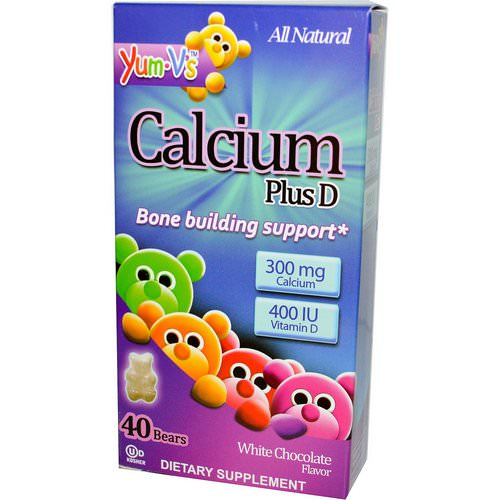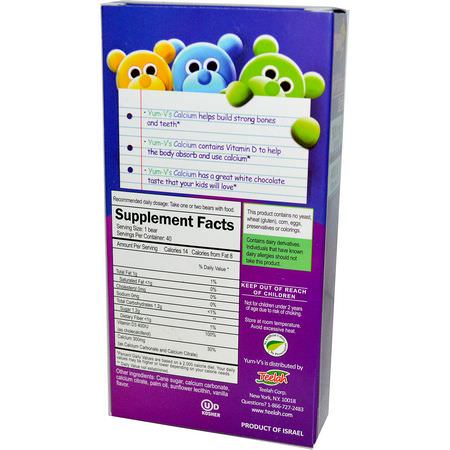Foodpharmacy Blog: Children's Calcium, Kids, Baby, Children's Health
YumV’s, Calcium Plus D, White Chocolate Flavor, 40 Bears

$6.30
Product name: YumV’s, Calcium Plus D, White Chocolate Flavor, 40 Bears
Quantity: 40 Count, 0.14 kg, 8.1 x 3.3 x 15.2 cm
Categories: Yum-Vs, Baby, Kids, Children’s Health, Children’s Calcium, All Natural, Kosher, No Artificial Colors, No Preservatives
All Natural, Bone Building Support, 300 mg Calcium, 400 IU Vitamin D, Kosher, Dietary Supplement, No Artificial Colors – No Preservatives, YumV’s Calcium helps build strong bones and teeth, YumV’s Calcium contains Vitamin D to help the body absorb and use calcium, YumV’s Calcium has a great white chocolate taste that your kids will love.

Children from the dunedin area of new zealand who avoided cow milk for any reason were eligible, regardless of whether they had made any attempts to increase their dietary calcium intakes from other sources. But there are steps you can take to reduce the amount of heavy metals you and your children are exposed to, and to minimize some of the effects of heavy metals. At the core of so many of the health problems children experience is a zinc deficiency that starts early on. The american academy of pediatrics recommends that fluoride supplements only be given after 6 months, and only to children whose primary water source is deficient in fluoride. This likely reflects the association between poor health and concurrent low vitamin d status rather than a causal relationship. Designed for children age three and older, the recommended dose is four gummies per day. Treatment involves increasing dietary intake of calcium, phosphates and vitamin d. Children on a gluten-free/casein- this diet were also more likely to be getting enough vitamin d than were the other children.
YumV’s, Calcium Plus D, White Chocolate Flavor, 40 Bears: Children’s Calcium, Children’s Health, Kids, Baby
Thus, although kids may need smaller amounts of vitamins and minerals compared to adults, they still need to get enough of these nutrients for proper growth and development. Vitamin d is an essential nutrient that plays an important role in calcium homeostasis and bone health. The dietary intakes of the milk avoiders in the present study would not meet the high calcium demands of pubertal growth. But there are more concerns beyond just bone health. What is not controversial, however, is that vdd, with or without dietary calcium deficiency, can lead to nutritional rickets (Nr), disturbances in calcium homeostasis, and osteomalacia. Twelve children (24%) Had previously broken bones. Vitamin d and calcium are important nutrients for skeletal growth and bone health.
Giving your child food when the fever has begun will only spike their temperature and make it more difficult to fight. Do kids have different nutrient needs than adults? But if a kid simply hates the taste or has trouble digesting milk, parents do not have to push it. Most commonly these involved vitamins d, e, calcium, potassium and choline. All non-breastfed infants, as well as older children, who are consuming less than 32 ounces per day of vitamin d-fortified formula or milk, should receive a vitamin d supplement of 400 iu a day. Our results strongly support the view that children with a history of long-term avoidance of cow milk have very low dietary calcium intakes and poor bone health in comparison with milk-drinking children. Ideally, a full dietary assessment of children who avoid milk consumption seems warranted to help identify possible nutritional deficiencies or excesses. Vitamin d and dental caries in children. Any chewable multivitamin supplement for kids that contains 400 iu of vitamin d is acceptable. Try to incorporate wild blueberries, blackberries, strawberries, and any other type of berries your children gravitate toward. The amount of calcium absorbed into our bones is dependent on the amount of calcium that we eat and how much vitamin d we get. Supplements made from calcium carbonate, the most common and least expensive form, are usually well absorbed and tolerated by healthy children.
For children to get their recommended intake of calcium and vitamin d, they should get 2-3 servings of dairy products and/or fortified foods (Such as fortified breakfast cereal and fortified orange juice) each day. Thus, whole-body bmc and bmd were approximately 9% and 5% higher, respectively, in the children born in winter to mothers randomised to cholecalciferol compared to those randomised to placebo. In addition, children with cancer and other diseases that cause increased nutrient needs may require certain supplements to prevent disease-related malnutrition. Maguire has found that children seem to have good iron stores and vitamin d levels at around two glasses a day, which is the current recommendation of the american academy of pediatrics. Supplementation is important, because most children will not get enough vitamin d through diet alone. More than 90 percent of parents with children 3 and under turn to these foods at least occasionally, a new consumer reports national survey of more than 3,000 people found. Together with vitamin angels, walgreens hopes to create a better and healthier world. Now, well-nourished children can get good amounts of calcium from their diet. And the surgeon general goes on to recommend calcium and vitamin d supplementation for children, adolescents, and adults. Conclusions: In growing children, long-term avoidance of cow milk is associated with small stature and poor bone health.
The classical function of vitamin d is in calcium and phosphate homeostasis. As a parent, you also should watch for any emotional impact that following a vegan diet might have on your child. If mom is getting enough thiamine, then her milk has enough for baby and supplements are not needed. The characteristics (Raw data) of the 50 milk avoiders are shown in table 1, all of the children were white and in good health. The bottom section of each category shows foods of more concern, listed in order of the number of servings that would present potential health risks to a child. The clinical evaluation and treatment of a child with rickets is discussed separately. Pth also promotes bone resorption by osteoclasts, thereby mobilising calcium and phosphate from bone mineral. Look for at least 100mg calcium/100ml on the nutrient information panel. Children in rural south african with habitually low dietary calcium intakes have lower appendicular bone mineral density (Bmd) than do control children who consume more calcium.
Yum-Vs Children’s Calcium
Feel free to encourage your children to eat as many bananas as they please because this amazing fruit is so essential to their health. Nutritional rickets is a devastating neuromuscular disease due to vitamin d status and/or calcium deficiency and continues to be an important global health problem. Added sugar has been tied to a host of health problems, from obesity to diabetes to heart disease. Of particular concern, around half of the children who had autism and were taking supplements were still not getting enough calcium. Similar to the situation in childhood, vdd is common in pregnancy. There is no rigorous data from studies of children about the safety of artificially sweetened drinks and other low-calorie sweetened beverages, she said, and the products can condition a child to prefer sweet drinks generally. However, many of the children in the study who were taking supplements were getting potentially unsafe amounts of vitamin a, folate and zinc. Milk usually provides 25% of the dietary protein of young children in western societies; therefore, the short stature of children who avoid milk could be due to inadequate dietary protein intakes.
Aside from bone mineral density and levels of 25(Oh)d (25-Hydroxy vitamin d) and parathyroid hormone, vitamin d insufficiency may be suspected based on several other biomarkers, including fractures or falls, intestinal calcium absorption, dental health, insulin sensitivity, beta-cell or immune functioning, respiratory disease such as wheezing or tuberculosis, and possibly hypertension. And over time, cadmium exposure can lead to kidney, bone, and lung diseases. The milk avoiders in the present study had sustained a high number of bone fractures, supporting the proposition that children who habitually avoid the consumption of cow milk who have low abmd values are vulnerable to fracture. Unless these children increase their intake of other calcium-rich foods or consume mineral calcium supplements to compensate for the lack of calcium from cow milk, they could be jeopardizing their bone health. In the interim it seems prudent to advise parents of all children who do not drink cow milk that they should seek professional nutritional advice to help optimize their children’s bone health. And studies show if you can build strong bones throughout childhood and adolescence, bone loss in later years will have less effect. Because we did not measure energy balance in our study, we cannot say whether the high adiposity of these children was due to excessive energy intakes or to inadequate energy expenditure. Vitamin d, along with calcium, is important for skeletal growth and bone health, and may also influence soft tissue body composition, foetal development and obstetric health.
Breastfed babies do not need additional calcium over that which they get from breastmilk and (During the second 6 months) complementary foods. What ingredients should be avoided in kids vitamins? A lack of calcium can lead to poor growth and osteoporosis later in life. You can learn more about the unknown cause of each of these conditions and how the liver is involved along with how your children can heal in liver rescue. The low calcium intakes of the study children are a concern because these children will need to increase their dietary calcium intakes considerably to correct their bone deficits and satisfy the greatly increasing mineral demands of the growing skeleton, particularly at puberty. Younger kids need less vitamin c, as well. Calcium is needed to grow healthy bones. Previous studies of bone health in children who avoid the consumption of cow milk were restricted to evaluations of children with symptoms of intolerance to ingestion of milk. This review highlights the history, risk factors, and controversies related to vdd during pregnancy and childhood with a particular focus on global nr prevention. But cadmium, inorganic arsenic, lead, and mercury (Especially methylmercury) can be toxic for everyone and pose particular risks for young children.
Multiple studies have linked vdd to adverse health outcomes in both children and pregnant women that extend beyond bone health. The eating behavior of children is strongly influenced by parental behavior. Moreover, long-term follow-up of children born to participants of these trials will determine whether any effects observed in the neonatal period, such as the effect of gestational vitamin d supplementation on increased bone mineralisation in children born in winter, does persist beyond the neonatal period. Another possible mechanism contributing to the high adiposity we observed in the milk avoiders was that their high body weights were linked to their low calcium intakes. Yet the precise definition of vitamin d deficiency and the healthy threshold for vitamin d levels lack universally agreed-upon standards. Most children begin to feel normal after a few weeks of taking iron pills. I discuss these foods and why they are important for everyone to avoid, including children, in my book thyroid healing.
About a third of children and adolescents in the united states are overweight or obese, conditions that increase the risk of developing chronic illnesses, such as high blood pressure, high cholesterol, sleep apnea, type 2 diabetes, heart disease, stroke and some cancers.